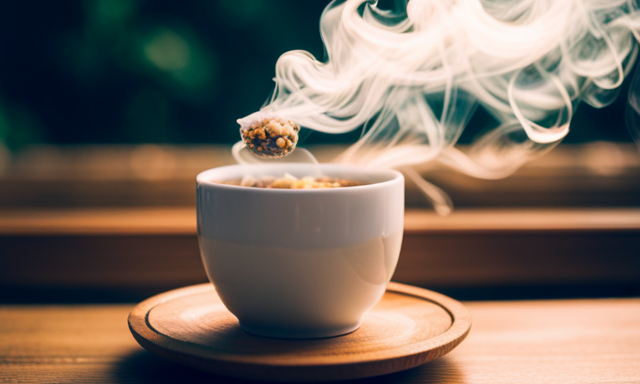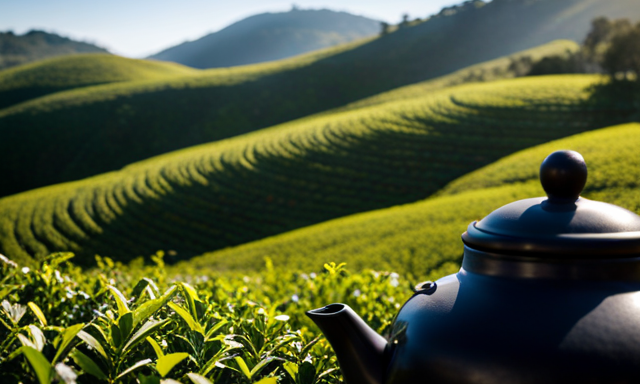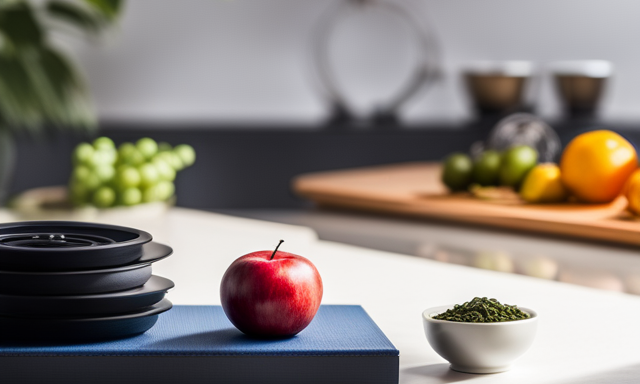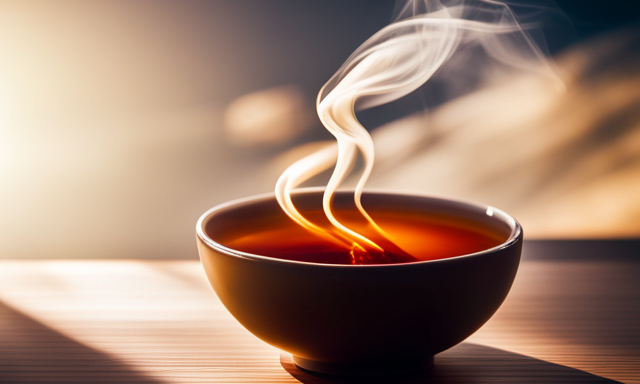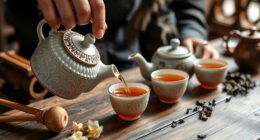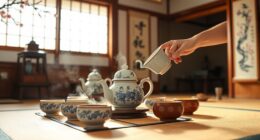I have always been a fan of tea, always on the lookout for new flavors and experiences. Recently, I discovered a special type known as oolong tea. Intrigued by its reputation for intricate taste profiles, I made the decision to delve into and discover what sets this tea apart.
Imagine sitting in a tranquil garden, surrounded by blooming flowers. As you take a sip of oolong tea, delicate floral and aromatic notes dance on your palate, transporting you to a world of elegance and refinement.
But it doesn’t stop there. This tea surprises you with fruity and citrusy undertones, adding a refreshing zest to each sip.
Yet, oolong tea goes beyond just its floral and fruity aspects. It also boasts earthy and toasty flavors, reminiscent of a warm, crackling fire on a cozy evening. And to top it all off, there’s a subtle sweetness and creaminess that lingers, leaving a delightful aftertaste.
Join me on this journey as we unravel the diverse varieties of oolong tea, discover the optimal brewing techniques, and explore the art of pairing it with food. Prepare to be captivated by the subtle nuances and exquisite taste of oolong tea.
Key Takeaways
- Oolong tea has a complex taste that falls between green and black tea, with a delicate balance of oxidation giving it a unique flavor.
- The fermentation process contributes to the flavor profile of oolong tea, resulting in a slightly floral and fruity aroma with a hint of nuttiness.
- Oolong tea is rich in antioxidants and offers health benefits such as aiding digestion, boosting metabolism, regulating blood sugar levels, and supporting heart health.
- Pairing oolong tea with desserts, such as creamy custards, rich chocolate cakes, and delicate pastries, enhances the overall sensory experience and balances the flavors on the palate.
Overview of Oolong Tea
If you’re curious about the taste of Oolong tea, let me tell you, it’s like a delightful dance on your taste buds, with a perfect balance of floral and fruity notes that will leave you craving for more.
Oolong tea has a unique flavor profile that sets it apart from other types of tea. It offers a complex combination of flavors, including hints of orchid, jasmine, and peach. The floral notes are delicate and fragrant, adding a touch of elegance to every sip. At the same time, the tea also has a subtle fruity sweetness, reminiscent of ripe berries.
Apart from its exquisite taste, Oolong tea is also known for its numerous health benefits. It is rich in antioxidants, which can help boost your immune system and promote overall well-being.
Transitioning into the subsequent section about ‘floral and aromatic notes,’ the taste of Oolong tea truly embodies a sensory experience that is both captivating and invigorating.
Floral and Aromatic Notes
Indulge in the delightful experience of savoring the fragrant and captivating floral and aromatic notes that dance upon your palate when you sip on a cup of Oolong tea.
Oolong tea is renowned for its exquisite floral fragrance and its aromatic complexity, making it a truly unique and enticing beverage. The floral notes in Oolong tea can range from delicate and subtle to bold and intense, depending on the specific variety and processing method.
These floral aromas provide a sensory experience that is both enchanting and invigorating, captivating your senses with every sip. The intricate flavors of Oolong tea are further enhanced by the interplay of various aromatic compounds, creating a tea that is rich in depth and character.
As you continue your exploration of Oolong tea, you will discover the fascinating world of fruity and citrusy undertones that await you.
Fruity and Citrusy Undertones
Experience the tantalizing burst of fruity and citrusy undertones that transport you to a sun-soaked orchard. The vibrant flavors dance upon your taste buds, leaving you refreshed and invigorated.
Oolong tea, known for its complexity, offers a delightful fusion of fruity and floral notes. Imagine sipping a cup of oolong and being greeted by the subtle sweetness of ripe peaches and the gentle tartness of oranges. These fruity elements intertwine with the floral essence, creating a harmonious symphony of flavors.
As the tea glides across your palate, you’ll also detect hints of zesty lemon and tangy grapefruit, adding a bright and invigorating twist. These citrusy and aromatic undertones provide a refreshing contrast to the delicate floral notes, resulting in a truly captivating tea experience.
And now, let’s delve into the next section to explore the earthy and toasty flavors that await.
Earthy and Toasty Flavors
Immerse yourself in the earthy and toasty flavors that envelop your senses, transporting you to a cozy fireside retreat. The richness of oolong tea is a result of its unique oxidation process, which gives it a distinct flavor profile. Here are four reasons why oolong tea’s earthy and toasty flavor is truly remarkable:
-
Aromatic Warmth: The deep, roasted notes in oolong tea create a comforting and inviting aroma that instantly soothes the soul.
-
Nutty Undertones: As you savor each sip, you’ll notice a delightful nuttiness that adds complexity and depth to the tea’s flavor profile.
-
Smooth and Mellow: The earthy taste of oolong tea is complemented by its smooth and mellow character, making it a perfect choice for relaxation and reflection.
-
Health Benefits: Beyond its delightful taste, oolong tea is known for its numerous health benefits, including boosting metabolism, promoting heart health, and aiding in weight management.
Now, let’s explore the next aspect of oolong tea: its sweetness and creaminess.
Sweetness and Creaminess
The sweetness and creaminess of oolong tea can be likened to a luscious dessert. A study has shown that it contains natural compounds that give it a richness comparable to a creamy caramel.
When exploring the sweetness of oolong tea, one will encounter a delightful sensation that is both soothing and indulgent. The delicate balance of flavors creates a harmonious symphony on the palate, with notes of honey and floral undertones dancing together.
As the tea glides across the tongue, a velvety smoothness envelops the senses, reminiscent of a decadent cream. The creaminess of oolong tea adds depth and dimension to its taste, elevating it to a level of sophistication and elegance.
This combination of sweetness and creaminess sets the stage for the subsequent section, where we delve into the balanced and complex taste profile of oolong tea.
Balanced and Complex Taste Profile
Prepare to be amazed by the intricate and harmonious flavor profile that oolong tea offers.
Oolong tea is renowned for its complexity and taste balance, making it a truly unique and sophisticated beverage.
The taste of oolong tea can vary depending on the specific variety, but in general, it strikes a perfect balance between the robustness of black tea and the delicate nuances of green tea.
The flavor is often described as floral, fruity, and slightly nutty, with a hint of sweetness.
Each sip reveals a complex dance of flavors that linger on the palate, creating a truly memorable experience.
As we delve into the different varieties of oolong tea, you will discover the fascinating world that awaits beyond this initial exploration.
Different Varieties of Oolong Tea
Take a journey through the diverse landscape of oolong tea varieties and let your taste buds dance to the symphony of flavors that await.
Oolong tea comes in many different varieties, each with its own unique taste profile. This is due to the different processing methods used to create oolong tea.
Some varieties are lightly oxidized, resulting in a delicate and floral flavor, while others are more heavily oxidized, yielding a richer and more robust taste.
The taste of oolong tea can range from fruity and sweet to earthy and toasty, with hints of honey, nuts, and flowers.
Not only does oolong tea offer a delightful taste experience, but it also provides numerous health benefits. From boosting metabolism to promoting heart health, oolong tea is a beverage that nourishes both the body and the soul.
As we delve into brewing techniques for optimal taste, prepare to unlock the full potential of oolong tea’s flavors.
Brewing Techniques for Optimal Taste
Embark on a flavorful journey by mastering the art of brewing oolong tea to unlock its hidden depths and maximize your tasting pleasure.
To achieve the optimal taste, it’s crucial to pay attention to the brewing temperature and steeping time. Oolong tea leaves are delicate and require a delicate touch when it comes to brewing.
The ideal water temperature for brewing oolong tea is around 185°F (85°C). Steeping time varies depending on the type of oolong tea, but generally ranges from 2 to 5 minutes. This allows the leaves to unfurl and release their complex flavors.
By following these brewing techniques, you’ll be able to savor the rich and nuanced taste of oolong tea.
Transitioning into the next section, pairing oolong tea with food enhances the overall sensory experience.
Pairing Oolong Tea with Food
Discover the art of enhancing your oolong tea experience by expertly pairing it with a tantalizing array of delectable foods. Oolong tea, with its unique flavor profile, can be beautifully complemented by various desserts.
The robust and slightly fruity notes of oolong tea make it a perfect partner for sweet treats like creamy custards, rich chocolate cakes, and delicate pastries. The natural sweetness of oolong tea enhances the flavors of these desserts, creating a harmonious balance on the palate.
Moreover, pairing oolong tea with desserts not only provides a delightful sensory experience but also offers several health benefits. Oolong tea is known to aid digestion, boost metabolism, and regulate blood sugar levels. By combining it with desserts, you can indulge in your favorite treats while still enjoying the many advantages that oolong tea has to offer.
Now, let’s transition into exploring the subtle nuances of oolong tea, where we delve deeper into its complex flavors and brewing techniques.
Exploring the Subtle Nuances of Oolong Tea
Let’s delve into the intricacies of oolong tea. A study found that the fermentation process of oolong tea leaves contributes to its unique flavor profile and health benefits.
Oolong tea, originating from China, is known for its complex taste that lies somewhere between green and black tea. The leaves are carefully plucked, withered, and partially oxidized before being heated to stop the fermentation process.
This delicate balance of oxidation gives oolong tea its distinctive flavor. It is characterized by a slightly floral and fruity aroma with a hint of nuttiness.
Beyond its exquisite taste, oolong tea also offers numerous health benefits. Rich in antioxidants, it aids in digestion, boosts metabolism, and supports heart health.
With its origins shrouded in ancient traditions and its myriad of health benefits, exploring the world of oolong tea is a captivating journey.
Frequently Asked Questions
How is oolong tea different from other types of tea?
Oolong tea stands apart from other teas due to its unique flavor and processing. The flavor of oolong tea is complex, with hints of floral and fruity notes, while its processing involves partial oxidation, giving it a distinct taste and aroma.
Does oolong tea have caffeine?
Oolong tea, symbolizing a delicate balance, does contain caffeine. While some may prefer its rich, earthy flavor over coffee, moderation is key. Excessive caffeine intake can lead to side effects like jitteriness and disrupted sleep patterns.
Can oolong tea be brewed multiple times?
Yes, oolong tea can be brewed multiple times using various brewing techniques. By steeping the leaves for shorter durations or increasing the water temperature, you can unlock new flavors and aromas with each infusion.
What is the best temperature to brew oolong tea?
For the best brewing methods of oolong tea, the ideal temperature is 190-200°F. This allows the flavors to fully develop, resulting in a rich and balanced taste that combines the sweetness of black tea with the freshness of green tea.
Are there any health benefits associated with drinking oolong tea?
Drinking oolong tea has been associated with weight loss and improved heart health. It is believed to help boost metabolism, burn fat, and lower cholesterol levels. Incorporating oolong tea into your diet may contribute to a healthier lifestyle.
Conclusion
In conclusion, exploring the world of oolong tea has been an enlightening journey. The taste of this exquisite beverage is a symphony of flavors that dance on the palate.
The floral and aromatic notes transport you to a fragrant garden, while the fruity and citrusy undertones add a refreshing twist.
The earthy and toasty flavors provide a grounding warmth, while the sweetness and creaminess bring a comforting embrace.
Each sip unravels a new layer of complexity, making oolong tea a truly captivating experience. Cheers to the subtle nuances of this remarkable drink!

